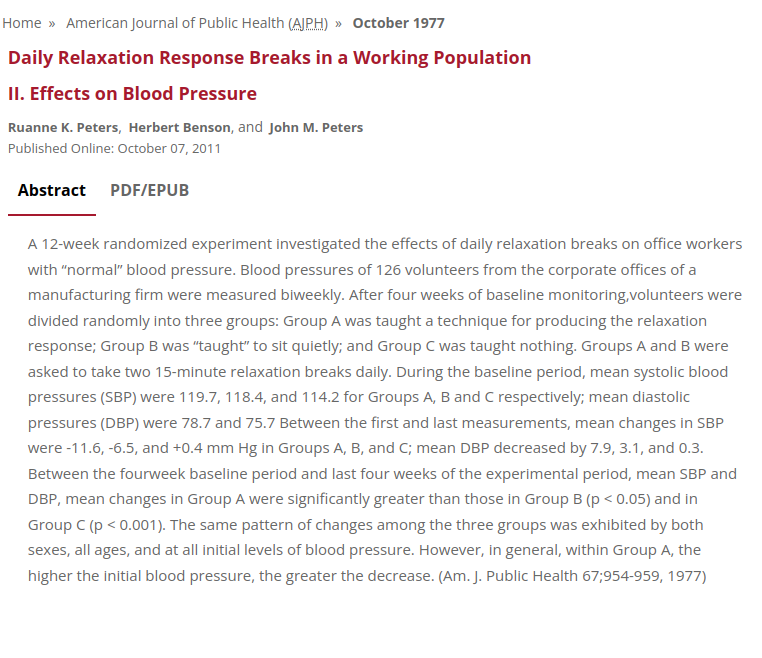A 12-week randomized experiment investigated the effects of daily relaxation breaks on office workers with “normal” blood pressure. Blood pressures of 126 volunteers from the corporate offices of a manufacturing firm were measured biweekly. After four weeks of baseline monitoring, volunteers were divided randomly into three groups: Group A was taught a technique for producing the relaxation response; Group B was “taught” to sit quietly; and Group C was taught nothing. Groups A and B were asked to take two 15-minute relaxation breaks daily. During the baseline period, mean systolic blood pressures (SBP) were 119.7, 118.4, and 114.2 for Groups A, B and C respectively; mean diastolic pressures (DBP) were 78.7 and 75.7 Between the first and last measurements, mean changes in SBP were -11.6, -6.5, and +0.4 mm Hg in Groups A, B, and C; mean DBP decreased by 7.9, 3.1, and 0.3. Between the fourweek baseline period and last four weeks of the experimental period, mean SBP and DBP, mean changes in Group A were significantly greater than those in Group B (p < 0.05) and in Group C (p < 0.001). The same pattern of changes among the three groups was exhibited by both sexes, all ages, and at all initial levels of blood pressure. However, in general, within Group A, the higher the initial blood pressure, the greater the decrease.
Daily Relaxation Response Breaks in a Working Population II. Effects on Blood Pressure
Publication
American Journal of Public Health
Abstract
Web and Email Links
Related Listings
Journal
Behavioral Medicine
To clarify the mechanisms of gender-related mind/body relationships, the authors analyzed the characteristics of 1,132 outpatients (848 women and 284 men) attending a mind/body medicine clinic. At entry in the program, the patients completed the Medical Symptom Checklist, Symptom Checklist-90 revised (SCL-90R), and Stress Perception Scale. Women reported 9 out of 12 symptoms (fatigue, insomnia, headache, back pain, joint or limb pain, palpitations, constipation, nausea, and dizziness) […]
Journal
PLOS ONE
Background Poor psychological and physical resilience in response to stress drives a great deal of health care utilization. Mind-body interventions can reduce stress and build resiliency. The rationale for this study is therefore to estimate the effect of mind-body interventions on healthcare utilization. Objective Estimate the effect of mind body training, specifically, the Relaxation Response Resiliency Program (3RP) on healthcare utilization. Design Retrospective controlled […]
Journal
American Journal of Public Health
A 12-week randomized experiment investigated the effects of daily relaxation breaks on office workers with “normal” blood pressure. Blood pressures of 126 volunteers from the corporate offices of a manufacturing firm were measured biweekly. After four weeks of baseline monitoring, volunteers were divided randomly into three groups: Group A was taught a technique for producing the relaxation response; Group B was “taught” to sit quietly; and Group C was taught nothing. Groups A and B w […]

